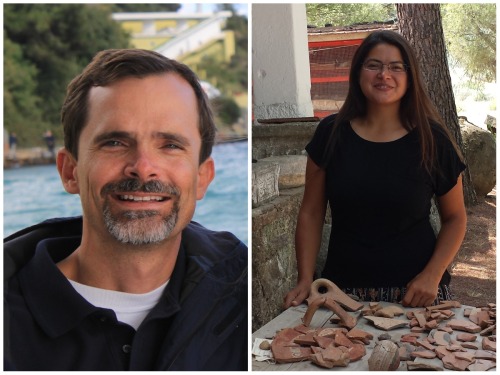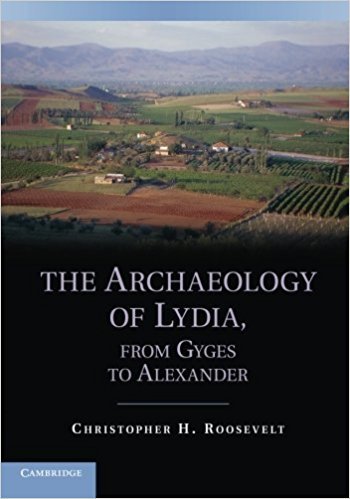
Güzin Eren, ANAMED PhD Fellow (2016–2017), and a PhD Candidate working on Lydian monumentality in the Department of Archaeology at Boston University, interviews ANAMED Director Chris Roosevelt following the recent translation of his book The Archaeology of Lydia, From Gyges to Alexander into Turkish…
ANAMED Director Chris Roosevelt’s book The Archaeology of Lydia, From Gyges To Alexander (2009) is now available In Turkish!
In his book The Archaeology of Lydia, From Gyges to Alexander(2009), Christopher H. Roosevelt, ANAMED Director, Associate Professor at ARHA and Co-Director of Gygaia Projects, weds the archaeological findings from Sardis, the ancient capital of Lydia, with results of his systematic regional survey in wider Lydia to present a diachronic and more holistic view of Lydian society from the 7th to the 4th centuries BCE. Roosevelt’s combination of various research methods including regional survey, environmental studies, investigations of archaeological finds at excavated sites and in local museums, and historical texts reveals continuities and changes in settlement patterns and burial practices throughout Lydia and how the Lydians took advantage of their environment for subsistence, resource control, and building edifices. Roosevelt’s book has just been translated into Turkish and published by Koç University Press (2017). On the occasion of this event, Güzin Eren, ANAMED PhD Fellow (2016–2017), and a PhD Candidate working on Lydian monumentality in the Department of Archaeology at Boston University, made a short interview with him.
GE: We have both worked at Sardis, the capital of ancient Lydia, but we never overlapped because you decided to look beyond Sardis and search for the Lydians in their wider region before I began my fieldwork. Could you tell us a bit about how your research on Lydian archaeology, hence the story of your book, began?
CHR: First, let me take this opportunity to thank you for showing interest in the book! Its origins go back to my work at Sardis, of course, which began in the mid-1990s thanks to advisors at Cornell University, Andrew Ramage and Peter Kuniholm, and the director of excavations at Sardis, Crawford H. Greenewalt, jr., who took risks in agreeing to train a neophyte with experiences only in Classics and Geology. Those experiences, however, came together happily in Lydia, where I quickly became enamored with archaeology and specifically that of western Anatolian landscapes and peoples, set between Aegean and Anatolian / Near Eastern cultures. After working at Sardis for several years, these interests manifested in questions about what else we knew about Lydians aside from the evidence at Sardis. Where else did Lydians live? How did they get by? How much did they interact with Sardians, if at all, and with those outside Lydia? These questions led to a study of the distribution of Lydian tumuli, or burial mounds (as markers of cemeteries and, hence, settlements) and eventually to work with museum archives and material collections and regional surveys (with many thanks to my co-director Dr. Christina Luke and our annual participants), the results of all of which came together in the book.
GE: Walking on the path to becoming a specialist on Lydian archaeology, I use your book as one of my reference guides. I know that only a few books on Lydian archaeology present Lydia diachronically through its material remains, but almost none are in Turkish. As your student, I am proud that your book is among the very few Lydian archaeology-related books translated into Turkish, and I am happy that the Lydians will meet an even wider audience as a result. First, when your book was published in English, how well was it received by the wider academic world and the general audience, and have there been any changes or developments in your approach to the topic since then? Second, I am curious to know how you felt holding in your hands the Turkish version of your book.
CHR: The original version of the book has been generally well received (as far as I know!), with published reviews providing general praise as well as constructive criticisms, especially concerning arguments about the nature and intensity of the Persian presence in Lydia in the late fifth and fourth centuries BCE, well after the eclipse of Lydian hegemony. Ironically, it is in the opposite chronological direction that my approaches to Lydian archaeology have moved, now focusing on the study of what we believe to have been a regional capital of the Pre- or Proto-Lydians, in the Late Bronze Age around 3,500 years ago: Kaymakçı. The site and its tentative association with the independent kingdom known to the Hittites as the Seha River Land was mentioned only briefly in the book.
How do I feel about the appearance of the Turkish version? Proud and pleased, first for its general acceptance and now also for its availability to the active scholarly community in Turkey engaged with aspects of Lydian archaeology.

GE: Could you tell us a bit about the translation process?
CHR: Working with Koç University Press was a real pleasure. My contacts were knowledgeably helpful and patient throughout the process and drew from their broad experience in selecting an appropriate translator (Hilal Gültekin Çatak) who aptly handled some of the more technical vocabulary.
GE: I know that you have a good grasp of the Turkish language. I was wondering whether you had the chance to examine the Turkish translation of your work. If so, how did you find it?
CHR: (You’re too kind.) I have of course examined the Turkish in the book and am pleased with the translation. My first glance was to see how “landscape” was translated, as it is used frequently throughout the volume. Avoiding the French-derived “peysaj,” the translator adhered uniformly to “çevre,” which I hope can convey the same flexibility of meaning.
GE: I found your book instructive not only because you present a synthesis of the archaeology of the Lydian era from its beginning to end, but also you do this with the approach of combining the findings of the only known urban site, Sardis, with new data from its hinterland to enable a discussion regarding changes and continuities in various practices of Lydian society. In a world in which regional surveys still seem to be applied only for finding important sites to dig, you emphasize, on the contrary, that regional archaeology can do so much more to learn about past societies, the evidence being the results of your book. Do you think that your methodological approach can be a model for future projects in Turkey, especially when it meets a wider audience?
CHR: It is most scholars’ secret (or not so secret) hope that their work will become a model for others. In this case, however, I myself followed the good examples of previous works that had attempted to combine the results of excavation, regional survey, and museum study into synthetic volumes shedding new light on past societies. Jack L. Davis’ Sandy Pylos: An Archaeological History from Nestor to Navarino (1998; University of Texas Press) is a particularly nice example of an edited volume that achieves this. Jeremy McInerney’s The Folds of Parnassos: Land and Ethnicity in Ancient Phokis (1999; University of Texas Press) was a closer model to follow as it focuses primarily on the most prominent era of a region’s history and is neatly presented through a single author’s narrative voice. If the Turkish version of my book is at all well received, of course I hope that others may be able to benefit from its methodology such that we will continue to see the publication of up-to-date regional syntheses for the varied and rich archaeological landscapes of Turkey.

